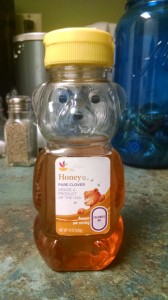I chose to write this post about the package for some honey I found in the kitchen of my suite. This stuck out to me as a good product to use for this post because, unlike many other uses of animals on food labels, bears are not used for production of honey.
The bears that are used in this product’s packaging are on opposite ends of the anthropomorphism spectrum: the bottle bear is so abstract that it displays very few human qualities, while the bear on the label has a very human-like expression and looks directly at the consumer. Although they are not as anthropomorphized as some other examples of food mascots, the way they are depicted is still very telling about how they are seen by the company that designed the packaging.
While the first bear, the bottle bear, does not exhibit particularly human traits, it has also been stripped of many of the things that make it a bear. The animal this bottle is shaped like has been stripped of its bear-ness, conveniently leaving a hollow shell to hold honey.
Meanwhile, the bear printed on the label is peeking over the brown region of the label in the way a human might, and looks directly at the viewer with a smile, something human added to the bear for the sake of advertisement. This anthropomorphized bear’s image is being exploited by humans for the sake of advertisement.
Foer defines anthropomorphism as, “the urge to project human experience onto the other animals” (Foer 46). This “urge” is exploited by the advertisers to allow consumers to make a connection the bear on the package, as bears are commonly associated with eating honey. By anthropomorphizing the bear on the label, people are encouraged to partake in the same activities as the bear, i.e. eating honey. The bottle bear contributes to this attempt at influence through anthropomorphization, as he is literally full of honey, just as the consumer should be.
The package for this honey shows how anthropomorphized animals’ images are exploited by food companies to further the industry’s own goals. In this case, that goal is selling honey. Foer’s definition of anthropomorphism as an “urge” plays right into this use of animals. or more accurately their images, in the food industry as instruments of marketing departments and tools of the giant food producers of the world.

Leave a Reply